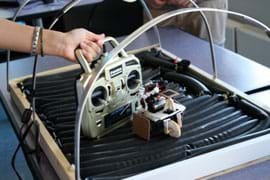
Each group needs:
- 4-channel radio transmitter; such as Futaba FUTK4200 (includes Futaba receiver R2004 GF and switch)
- 4-cell battery box and switch harness; such as TOWM6220 available at http://www.towerhobbies.com/
- 2 continuous rotation servos; such as Parallax 900-00008 (Futaba) Continuous Rotation Servo available at https://www.robotshop.com/
- 2 180-degree rotation servos; such as Futaba S3003 Servo Standard, available at http://www.towerhobbies.com/
- 42-gallon black plastic contractor garbage bag; a box of 20 for the entire class
- Engineering Design Quiz, one per person
- Design Project Description Handout, one per person
- Competition Scoring Rubric, one per team
Materials to make one synthetic abdominal cavity simulator for the class to share:
- 2 gallons of white Elmer's School Glue
- borax, 16 oz. box; available in grocery stores in the laundry detergent aisle
- measuring spoon, 1 teaspoon (for solids)
- measuring cup, minimum 2 cup size (for fluids)
- 2 plastic containers, for mixing glue and water, and borax and water
- water, ~20 cups
- 4-in clear zip ties, pack of 100
- scissors
- 1-in x 2-in x 12-ft wood board
- 1/4-in thick x 2-ft x 4-ft sheet plywood
- 1/8-in x ½-in x 9-ft aluminum strip; such as McMaster 8975K527 available at http://www.mcmaster.com/
- 1½-in long wood screw, quantity 8; such as McMaster 92114A138
- ½-in long wood screw, quantity 30; such as McMaster 93360A220
- drill with 5/64-in (for aluminum) and 1/16-in (for wood) size bits
- black contractor garbage bag (42-gallon size), for making two semi-circle shaped end flaps
- standard light bulb socket and cord with switch; $9 (or else specify that robots provide their own illumination)
- energy-efficient fluorescent bulb; such as SLI Lighting spiral soft white energy-saving bulb, 75 watts, available at https://www.solarlightingitl.com/
- electrical tape
- PlayDoh party pack, 10 mini cans, to represent endometriosis lumps
- Building Instructions for Synthetic Abdominal Cavity Simulator, one copy for teacher
If using latex tubing in the simulator:
- abrasion-resistant natural latex rubber sheeting .02-in thick, 6-in width, 30-ft long; such as McMaster 85995K16 available at http://www.mcmaster.com/
- super glue, 1 oz (28.3 g) bottle; such as Loctite Super Bonder 496 Instant Adhesive
- 1.5- to 2-in diameter PVC pipe, for use in crafting a tube from the latex sheet (exact pipe diameter is not that important)
If using bicycle inner tubes in the simulator (a less expensive alternative to latex tubing):
- 7 used bike tubes of any diameter (easily obtained for free at any bike shop; cut out sections with holes or damage)
To share with the entire class:
- miscellaneous crafting materials such as foam core board (discarded plastic election yard signs work really well), Popsicle sticks, press board, string, hot glue and hot glue guns, masking tape, duct tape, wooden dowels of various sizes, paper clips, pipe cleaners or twist ties, tooth picks, rubber bands, scissors, box cutters, etc.
- sticky-back Velcro, 15-ft x ¾-in tape for everyday use
- if manufacturing or prototyping equipment is available, such as a laser cutter, 3-D router, table saw, hand drill, etc., consider making available other materials (such as Plexiglas) for second- and third-iteration prototypes
- remote (wireless) miniature color camera; such as the Mini 5.8 GHz Wireless Spy Camera with PC USB Adapter available at: https://www.spygearco.com/SetOf4MiniWireless5.8GhzColorSpyCamerasWithPCUSBAdapter-DS.htm, (Note: Do not buy a wireless camera that operates at 2.4 GHz since this is the same frequency as the transmitters and will cause electrical interference.)
- scale, accurate to 0.1 g; such as Se digital pocket scale
- stopwatch
- computer and projector (or overhead projector) to show the Electronics Introduction Presentation.
Note: Expendable costs are estimated at $88 for 7-8 groups because you cannot usually buy the items in smaller quantities (so it works out to ~$11 per group). All other "start-up" non-expendable material costs are for reusable items, such as the supplies to build the electronics and abdominal cavity simulator. For materials that will be shared with the entire class (simulator, camera, scale) the total comes to $298. You can save $64 by using used bicycle tubes (free at local bicycle shops) instead of latex sheeting. The electronics come to $146 per group.
 https://www.teachengineering.org/activities/view/cub_surg_lesson01_activity2
https://www.teachengineering.org/activities/view/cub_surg_lesson01_activity2